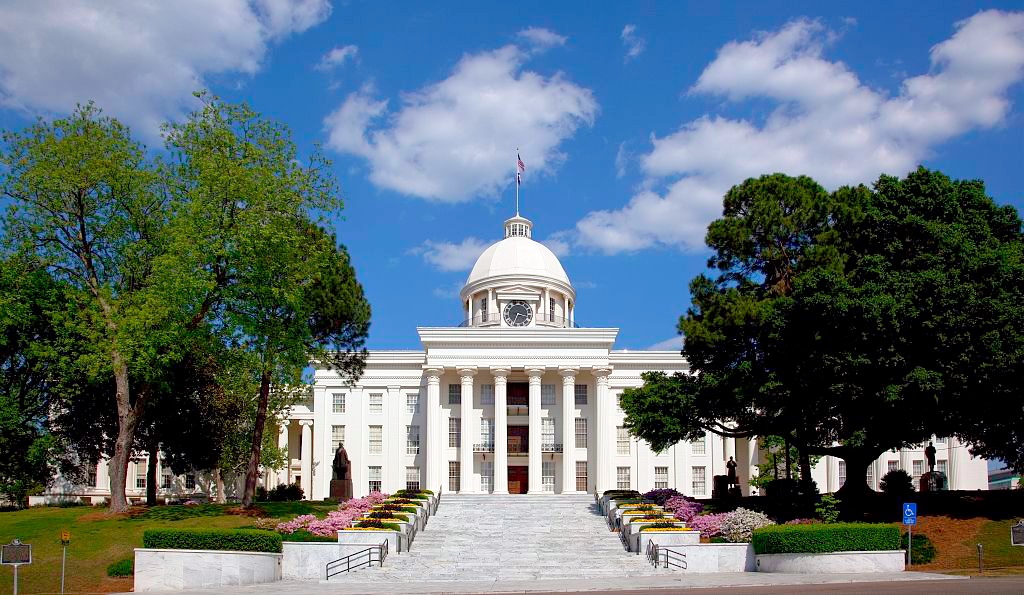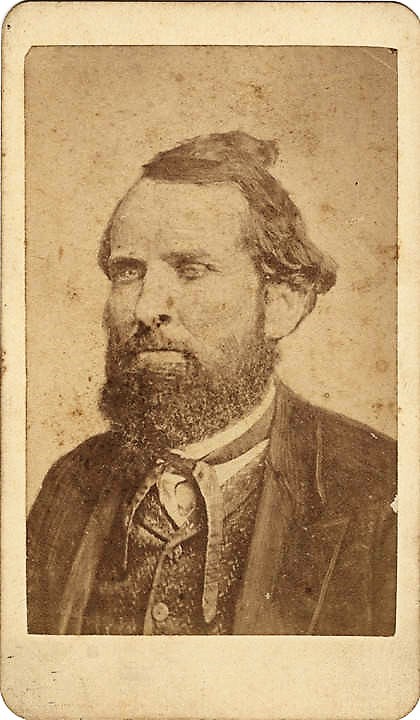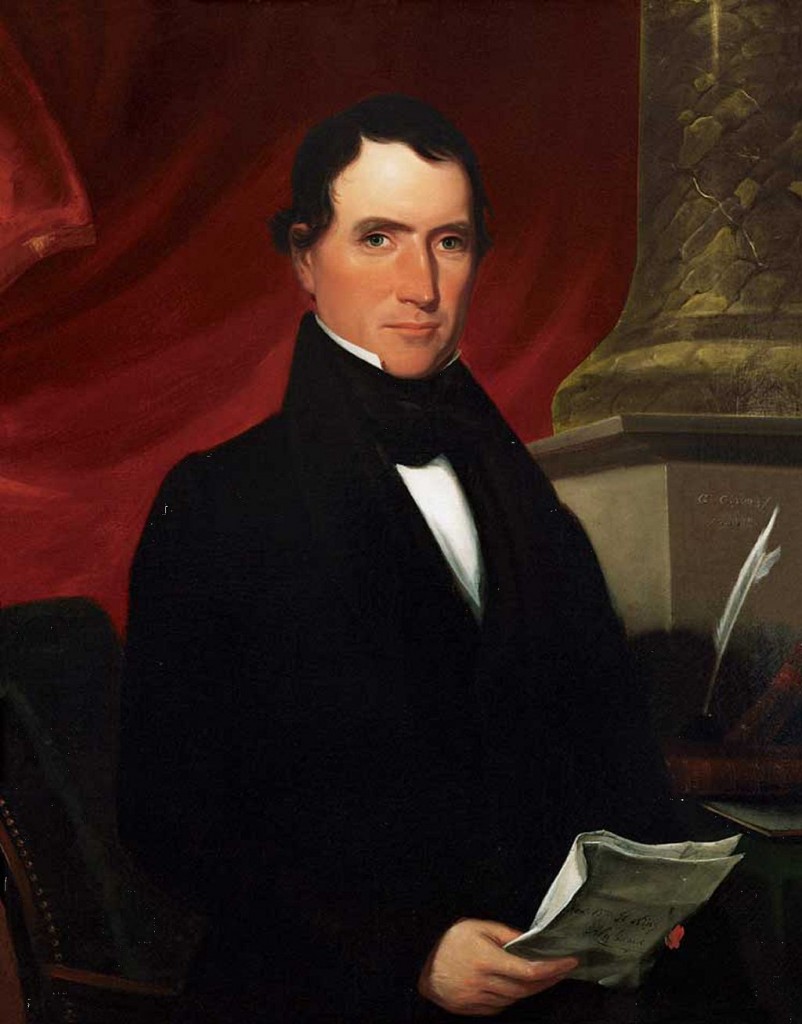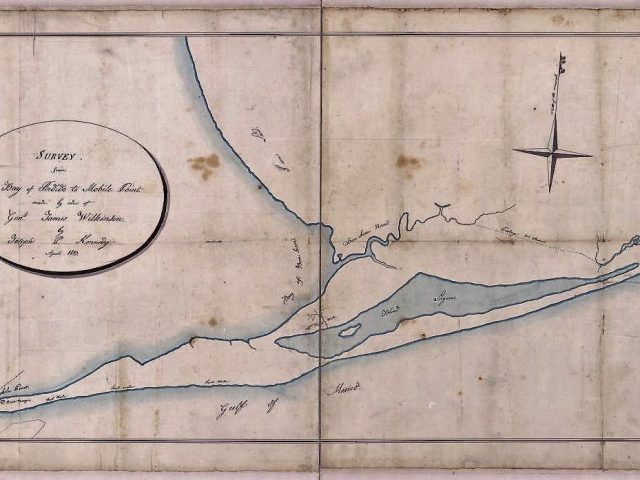Excerpt from
ALABAMA STATE CAPITOL
AN HISTORICAL SKETCH,
Brochure
by
JAMES B. SIMPSON,
Late Recording Secretary to the Governor
JANUARY 1898
Roemer Printing Co., Montgomery, Ala, Printers
POINTS OF INTEREST
(At the State Capitol in Montgomery, Alabama in 1898)
To the stranger there are many points of interest about the Capitol. The most striking, probably, is the spot on the portico marked by the star showing the place where Jefferson Davis stood while taking the oath of office as President of the Confederate States. The star was placed there by the Sophia Bibb Chapter of the Daughters of the Confederacy.
Unlock all stories
Join our Alabama Pioneers Patron Community!
Become an Alabama Pioneers Patron
In a handsome cabinet in the office of the State Treasurer is the Bible on which this oath was administered. This Bible was bought for the executive office of the State in 1852 On the inside of the front cover is the following note, or memorandum:
“The oath of office as first President of the provisional government of the Confederate States of America, was administered to
JEFFERSON DAVIS,
upon this Bible, by Howell Cobb, President of the Provisional Congress, at the front portico of the Capitol in Montgomery, on the 18th day of February, A. D. 1861.” On the opposite page is the following endorsement or certificate:
“Montgomery, Ala., November 21, 1881. I certify that the note or memorandum on the opposite page is in the handwriting of my father, the late Judge John D. Phelan, who was, at the time of the inauguration of Mr. Jefferson Davis, clerk of the Supreme Court of Alabama, and I have often heard him say that he witnessed the inaugural ceremonies. This certificate is made by request, in order to perpetuate as far as may be, the authenticity and reliability of said note or memorandum.
“In testimony whereof I hereto set my hand and also affix the great seal of the State, the month and day and year above written.
“ELLIS PHELAN,
“Secretary of State.”
Mr. Phelan, who was Secretary of State of Alabama at the time of attesting to the handwriting of his father, Judge John D. Phelan, is now a resident of Waterbury, Conn., where he holds an important judicial position. Attached to the cover of this Bible is, also, an autograph letter from Mr. Davis.
On the first floor of the Capitol at the northern end are the offices of the Governor and of the Secretary of State. At the southern end of the building are the offices of the State Treasurer and of the State Auditor. On this floor at the eastern end is the Supreme court room and adjoining the courtroom on the east is the Supreme Court library, which is the lower floor of the addition to the Capitol, built at a cost of $25,000, in 1885.
Gen. James Holt Clanton (Alabama Department of Archives and History)
On the second floor at the northern end of the building is the Senate chamber and at the southern end is the hall of the House of Representatives. This hall is of a particularly historic interest, because it is the chamber in which was adopted the ordinance of secession, and here the Provisional Congress of the Confederate States of America met and the representatives of the seceding states organized the government of the Confederacy. Over the Speaker’s chair in the hall of the House hangs a portrait of Gen. Jas. H. Clanton, who was one of the most gallant cavalry leaders in the Southern army during the war. He was an attorney at law, and after the war settled in Montgomery to engage in the practice of his profession. In 1871 the State of Alabama was engaged in litigation with the Alabama Great Southern Railroad. The cause was set for trial in the United States court at Knoxville, Tenn., and General Clanton was engaged by the State to represent its interests. During the course of the trial, a difficulty took place between General Clanton and David M. Nelson, one of the attorneys on the opposite side, and Nelson shot General Clanton with a doublebarrelled shot gun, killing him instantly. The body was brought to this city and was interred with distinguished honors. The portrait of General Clanton was hung in the hall of the House of Representatives shortly afterwards. Some years ago in the Senate chamber there hung a portrait of Hon. Wm. R. “King, the Alabamian who was elected Vice-President of the United States in 1852, but it was removed temporarily at one session of the Legislature and placed in an ante room, where some one, unknown, cut the portrait out of the frame. A diligent search has been made for the lost picture, but it could never be found. Mr. King never took his seat as Vice-President. His health was bad and before the time for his inauguration he went to the Island of Cuba, where a messenger was sent by the government at Washington, and administered to him the oath of office in March, 1853. Mr. King’s health did not improve and he returned to his home in Dallas county, where his death occurred in April, 1853.
Vice-President William Rufus King
The State officers on the second floor are: The Superintendent of Education, the Attorney General, the Chief Justice and Associate Justices of the Supreme Court, the Railroad Commission, the Clerk of the Supreme Court and the State Tax Commissioner.
The third floor of the building is occupied by the following officers: State Health officer, Adjutant General, Commissioner of Agriculture, Reporter of the Supreme Court, the Board of Convict Inspectors, and the Examiners of Public Accounts.
The Supreme Court Library contains a fine legal library, interspersed with a large number of miscellaneous books. On the walls of the library are portraits of the following Governors of Alabama: Thomas Bibb, John Murphy, Gabriel Moore, John Gayle, Clement C. Clay, Benjamin Fitzpatrick, Joshua L. Martin, Reuben Chapman, Henry W. Collier, John A. Winston, Andrew K Moore, John G. Shorter, Thomas H. Watts, Robert B. Lindsay, George S. Houston, E. A. O’Neal, Thomas Seay, Thos. G. Jones, and Win. C. Gates.
Besides the portraits of the Governors, there are on the walls of the Library portraits of Jefferson Davis, Hon. John Foster, for years a distinguished judge and chancellor, Wm. L. Yancy, the brilliant orator of the period just before the secession of the State, Ex-Senator James L. Pugh, Marion A. Baldwin, who was for many years Attorney General of the State, and John A. Elmore, of Montgomery, who was in his time one of the most distinguished members of the Alabama bar.
In the Supreme Court room there is a collection of portraits of the Chief Justices of the Alabama Supreme Court from the time of its organization to date, with the exception of one, Chief Justice E. W. Peck. The list is as follows: Edmund S. Dargin, of Mobile; Reuben Saffold, of Dallas; Arthur F. Hopkins, of Mobile; George W. Stone, of Montgomery, Wm. P. Chilton, of Montgomery; George Goldthwaite, of Montgomery; Samuel F. Rice, of Montgomery; Henry W. Collier, of Tuskaloosa; Abner S; Lipscomb, of Mobile; Thomas M. Peters, of Lawrence; Henry Hitchcock, of Mobile, and Robert C. Brickell, of Madison.
Chief Justice Clement C. Clay, Jr., was in turn Governor, United States Senator and Chief Justice of the Supreme Court.
Abner S. Lipscomb, after retiring from the Supreme bench in this State, removed to Texas, and was elevated to the chief justiceship of the Supreme Court of that State.
Chief Justice Henry W. Collier was elected Governor of the State after having retired from the bench.
The collection of the portraits of the Governors of the State, and of the Chief Justices is the work of the efficient librarian, Mr. J. M. Riggs, who has devoted much time to this matter, and while he has the collection of portraits of the Chief Justices complete, with the exception noted, he is working untiringly to add to the number of portraits of the men who have filled the Gubernatorial chair.
The view from the dome of the Capitol is one of the finest in the State. In the distance can be seen the range of hills encircling Montgomery, while laid before the sightseer is a birds-eye view of the city, with its hills and shaded trees.
Recently the local chapters of the Daughters of the Confederacy have begun to collect relics of the Confederacy. Those of the Sophia Bibb Chapter are in cases in the rotunda. Those of the Cradle of the Confederacy Chapter are in the Governor’s office in a book case which belonged to Governor Watts during the war.
ALABAMA FOOTPRINTS – Volume I – IV: Four Volumes in One
The first four Alabama Footprints books have been combined into one book,
From the time of the discovery of America restless, resolute, brave, and adventurous men and women crossed oceans and the wilderness in pursuit of their destiny. Many traveled to what would become the State of Alabama. They followed the Native American trails and their entrance into this area eventually pushed out the Native Americans. Over the years, many of their stories have been lost and/or forgotten. This book (four-books-in-one) reveals the stories published in volumes I-IV of the Alabama Footprints series.







